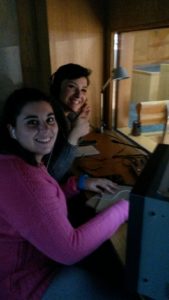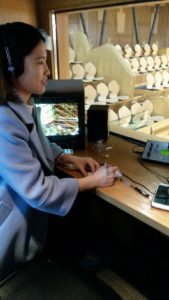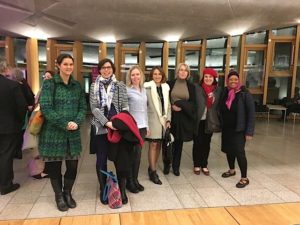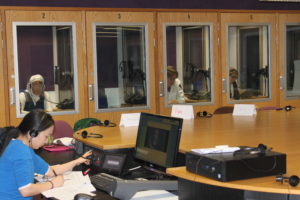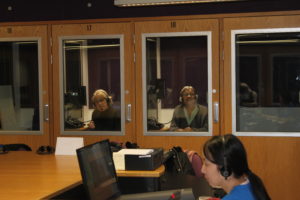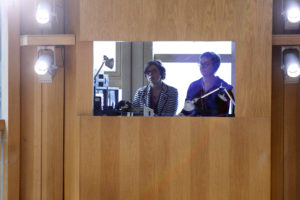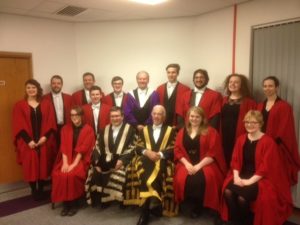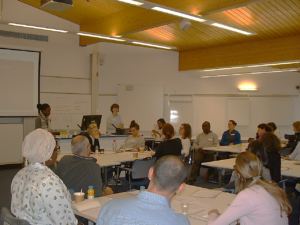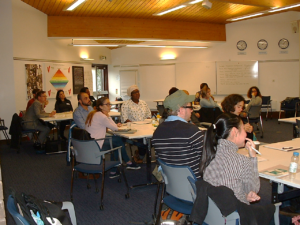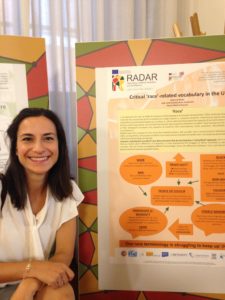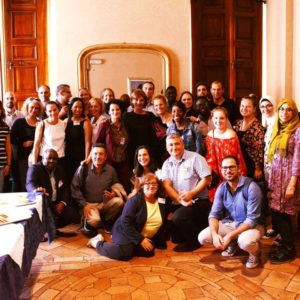by Michael Richardson
This blog-post is based on an article to be published in the October 2016 edition of the British Deaf News, and is reproduced here with their kind permission.
As I write, the final day of the 2016 Edinburgh Festival Fringe is drawing to a close. During a three-and-a-half week period there will have been over 50,000 performances of more than 3,000 different shows: it is easy to accept the claim that this is the largest arts festival in the world. But how many of these performances are accessible to Deaf people? The Fringe is committed to improving the accessibility of Edinburgh venues and its own box office, but as it takes no role in choosing any of the shows, it is left to each visiting company whether or not to make their performances accessible to Deaf spectators.
Deaf people’s involvement in theatre, whether watching or performing, is my own particular interest. For almost ten years I have been exploring the use of BSL on stage, in both youth theatre and musical theatre. A show I produced for Edinburgh Music Theatre which used integrated sign language interpreting was featured on the BBC’s See Hear as one of only a handful of performances providing accessibility for Deaf spectators in the 2011 Fringe.
I am now doing a PhD at Heriot Watt University in Edinburgh, researching Deaf people’s participation in theatre, so the 2016 Fringe seemed an excellent opportunity to review progress towards better access for Deaf people. The timing was particularly appropriate as I have just completed a project interviewing a small group of Deaf people on the subject of theatrical interpreting. So, debit card at the ready, I logged on to the Fringe website and began my search for sign language interpreted performances.
The first good news I can report is that the amount of interpreted theatre has increased since 2011. The Fringe website’s own list of performances accessible to Deaf people featured 31 different shows, of which 11 were interpreted on 2 or more occasions. In addition, in the Free Fringe the Deaf and Hearing Ensemble worked with Forest Fringe to present a whole day of BSL interpreted shows at the venue Out of the Blue. Certainly there are more options to choose from for Deaf spectators than in earlier years.
Interpreted shows included a wide range of performance styles. Drama, physical theatre, circus, children’s shows and comedy were all represented, as well as traditional Scottish storytelling and music, a choir performing African song and dance, and a skit of the Eurovision Song Contest. More choice was offered by the use overall of a relatively large pool of interpreters. Still lacking, however, was a strong presence by Deaf actors. The Fringe website listed only one bilingual (BSL/English) theatre show, which I will describe later; and a one off spoken word event performed by my colleagues, two Deaf and two hearing from Heriot Watt University (Jemina Napier, Gary Quinn, Stacey Webb and Mark McQueen).
Incidentally, although the accessibility pages of the Fringe website are not easy to find, once you have clicked through they are increasingly good at giving the kind of extra information that Deaf theatre goers asked for in my research project. 75% of the shows described as accessible had a named interpreter advertised, and over 30% either gave the position of the interpreter or offered the option for Deaf spectators to choose appropriate seats when they arrived at the venue.
This kind of pre-show communication is certainly starting to address the first requirement of accessibility: that target audiences need to be fully aware in advance of all relevant details of the accessible event (although in 2016 no information was presented in BSL, a situation which may change following the BSL (Scotland) Act 2015). However, I am particularly interested in the communication that occurs during the show, and the ways that it engages Deaf spectators. My Deaf research participants had been clear that in interpreted theatre they expect a particular style of high impact interpreting that matches the performances of the actors and is presented within the same visual frame as the performance, so I set out to see if theatre companies and interpreters were meeting these expectations.
I was not disappointed. At Forest Fringe I watched three shows where there had been rehearsal time put aside to integrate the interpreting into the show as much as possible. In all three the interpreters were costumed effectively to match the actors, but the choices of shows had an impact on the degree of further integration. Nic Green’s Cock and Bull, interpreted by Catherine King, was an avant garde political satire that was highly visual and sexually provocative. This accessible visual style was contrasted with a complex script in which sentences were broken into individual words and even parts of words, with actors overlapping different lines with songs and voice-over. This combination of a very physical staging with a difficult spoken text unavoidably limited the fuller integration of the interpreter.
The other two Forest Fringe shows, both interpreted by Yvonne Strain, presented fewer challenges. Greg Wohead’s Celebration Florida allowed her to be both costumed and fully integrated into the action, moving with the two actors and giving Deaf spectators an equivalent experience to hearing audiences of the show’s exploration of nostalgia for forgotten experiences, people and places. A different approach was taken for Action Hero’s Watch Me Fall, a show which used home-made stunts to question our relationship with ideas of tough-guys and daredevils as celebrities. Possibly for her own safety as much as for anything else, the interpreter took a fixed position on the side of the performance area. Rather than being integrated into the show she performed as though a member of the standing audience, reacting as we did to the stunts, but also interpreting the announcements between the stunts and the few short sections of dialogue as they occurred.
Away from Forest Fringe I saw two shows interpreted by Yvonne Waddell, a PhD candidate at Heriot Watt University, in which she had worked independently with the companies to provide as much integration as possible. Ronan O’Donnell’s Brazil is a one man show set in an imagined Scotland destroyed by the bombs of war and living in poverty and mistrust. Yvonne provided a highly visual BSL interpretation to match the poetic language of the original, and was fully integrated into the show. She was costumed, and performed from on the small stage close to the speaking actor. At significant moments the two made eye contact, effectively suggesting that they represented two different sides of the same character.
A different style of integration was used in Lemons Lemons Lemons Lemons Lemons by Walrus, a play with two characters exploring their changing relationship in a world where they were only allowed to use 140 words per day. Here Yvonne Waddell worked with Greg Colquhoun, a recent graduate of Heriot Watt University (MA British Sign Language (Translation, Interpreting and Applied Language Studies)). The interpreters were less integrated into the action, standing on one side of the theatre-in-the-round stage, but each interpreter represented one character throughout, fully costumed, partly shadowing their actors and often using a word to sign literal translation to reflect the way that English words were used in the original. The matching of the interpreters to the actors was particularly effective and is hopefully a sign of things to come in theatre interpreting.
I cannot finish this article without discussing further the work of the Deaf and Hearing Ensemble. Individual interpreters are doing what they can to improve the experience of Deaf spectators, but this company bring a strategic approach that is shown in their partnership with Forest Fringe. In addition, this year they performed their own show People of the Eye, featuring one Deaf and one hearing actor and using a mix of BSL, speech and creative captions to tell the story of a Deaf girl growing up in a hearing family. The show puts across the combination of humour and anguish that is often a Deaf child’s experience through a mix of emotional dialogue and tightly choreographed physical and visual theatre. The aim is to create accessible bilingual theatre that both engages and educates audiences, and the four and five star reviews it received demonstrate that this was achieved.
Unfortunately People of the Eye was (to my knowledge) the only theatre show to feature a Deaf actor at the Edinburgh Fringe in 2016, although there was also a bilingual BSL/English poetry event (that I was unable to attend). For me (and others) this raises the question of why significant sums of money are put into theatrical interpreting rather than using at least some access funding to support Deaf actors and Deaf theatre: a show like Deafinitely Theatre’s recent production of George Brant’s Grounded would be a perfect fit for the Fringe. But for now we can be clear about one thing. The use of BSL in performances at the Fringe is increasing, and interpreters and theatre producers are working hard to do it better, and to make interpreting more integrated. As signed performances become more common place, hopefully an appetite will grow in theatre audiences to attend performances by Deaf actors using BSL, thus coming to appreciate Deaf language and culture and all they can offer to the creation of high quality physical and visual theatre.
***
